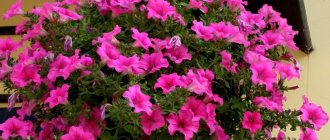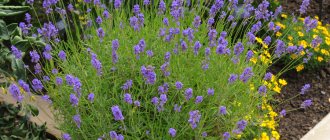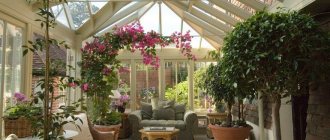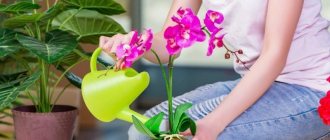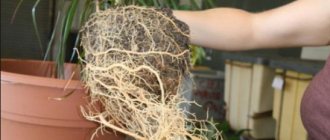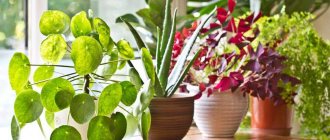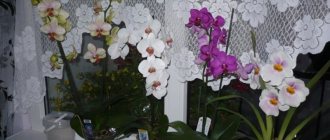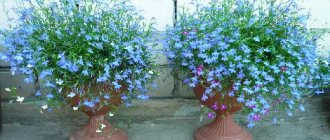What types of flowers are there to grow in pots?
Landscape designers and experienced housewives often create incredible color compositions in the courtyard of a house or cottage. To make a hanging garden look beautiful, you need to know what types of flowers are suitable for this purpose and how to properly care for them.
Ampelous flowers
There are several types of plants for growing in hanging containers:
- curly;
- creeping;
- multi-socket;
- blooming;
- succulents;
- decorative deciduous;
- creeping.
Flowering plants
Flowering ampels include:
- petunia;
- begonia;
- lobelia;
- viola;
- fuchsia;
- diascia;
- catharanthus;
- verbena.
Flowering plants for pots
Resistant to direct sunlight
Most hanging plants for pots tolerate sun well. But still, it is better to place the flower pot so that the midday sun does not fall on it.
Plants that are not at all afraid of sunlight:
- petunia;
- verbena;
- bidens;
- Moorish bindweed.
Important! It is necessary to provide these plants with frequent watering on hot days, in the morning and evening.
Wind resistant
Hanging outdoor flowers for pots are quite resistant to winds. But during severe bad weather, it is better to put them indoors. Pots with flowers should be placed in a place where there are no constant drafts.
Hanging spurge is considered the most resistant to strong winds.
Flowerpots
Classification Features
From a botanical point of view, there are many forms of such plants - climbing (beans, bindweed), climbing (grapes, hops), creeping (all ground cover), “mustachioed” (chlorophytum, episcia). Landscape and indoor designers include in this group all plants that can be planted in a hanging container with the stems hanging down. They, in turn, are divided into flowering and decorative foliage varieties. Plants that cling to supports and crawl upward are classified as vines, although by and large they are also ampels.
The best flowers for the garden
Ampelous petunia - growing in hanging pots
To create a beautiful flower arrangement for the garden, the following flowers are suitable:
- rose;
- carnation;
- cottonweed;
- hibiscus;
- cosmos;
- morning glory;
- gaillardia;
- gazania;
- veronica.
Imopoeia seeds
Growing hanging flowers for the garden
To make the ampels in the garden look beautiful, you need to know the peculiarities of their planting and choose the right place for each type of plant. It is also necessary to know how to care for them: water, fertilize, propagate, prune, replant.
Important! You should choose the right container for each plant and the right soil.
Hanging Garden
Selecting a location
Hanging gardens should be planned in open areas so that the sun's rays illuminate them all day long. Then the flowering bushes will be lush and beautiful. There is no need to place the ampels in drafts, as in this case they may die.
Flowerpot plants should be planted in the evening or on a cloudy day. Then they will be well accepted and grow.
The soil for these flowers should be loose and breathable. You can mix peat and regular soil in different proportions and add a little sand.
For lush flowering, you need to fertilize the soil once every 10 days with universal products. Watering should be abundant and regular. On hot days you need to water twice a day, on cool days - once a day.
For your information! You can order seedlings and delivery of hanging flowers on the Internet. Along with the flower will come a detailed description of the features of caring for it.
Bacopa
Very loved by European gardeners, but little known in Russia. Recently, it has been rapidly gaining popularity among lovers of landscaping loggias and summer pavilions. The plant has about 100 varieties, most of which are aquatic species.
Bacopa ampelous is known to most gardeners as sutera. Its homeland is considered to be Africa and the tropical part of South America.
These ampelous flowers have an attractive appearance. Its drooping shoots are very densely strewn with small flowers of pink, white or blue.
Sutera loves abundant watering and requires frequent moistening. Perhaps, this is where all the features of caring for her end. Otherwise, she is completely unpretentious. Bacopa grows equally well both in partial shade and in full sun, and is not afraid of temperature changes.
It goes well in flower arrangements, but alone it can compete with any ornamental plant.
Ampelous flowers for pots hanging in the apartment
The most popular hanging indoor plants are:
- Wood's Ceropegia. It has light red and dark green leaves with white stripes.
- Chlorophytum. It is often called the green lily. It grows and develops well even in dark rooms. It is usually placed in the kitchen or in places where there are a large number of people, as the plant perfectly purifies the air.
- Dichondra. Excellent for hanging baskets and does not require special care.
Ampelous petunia - growing in pots and care
There are a huge number of hanging plants that can be used to decorate a house or apartment in hanging containers. The most popular are fuchsia and begonia.
Fuchsia ampelous
Belongs to the fireweed family and comes in different varieties. This climbing plant should only be planted in flowerpots; in ordinary pots it will not be able to show all its beauty.
Fuchsia varieties:
- Golden marinka - elongated flowers with a white center, light green leaves have a golden tint.
- Icicle has large white flowers, sometimes with a pink tint.
- First love - flowers are presented in purple colors from light to dark.
- Fairy – white and red flowers.
- Golden Monica - large double flowers of a pink hue.
- La fiesta - bright crimson flowers with light sepals.
Fuchsia should be placed in partial shade so that the midday sun does not hit the plant. The pot should be small. The soil is universal. In the warm season, fuchsia can be kept outside or on the balcony, in winter - in a warm room.
Important! At the beginning of spring, the plant should be transplanted into a larger pot.
Begonia: variety of forms and types
Begonia is an unpretentious plant that has beautiful bright flowers up to 8 cm in diameter, asymmetrical leaves, and a beautiful bush shape. Petals can be double or single. The color scheme is represented by all shades of red, and also comes in white, orange and yellow.
The pot for begonia seedlings should be shallow and wide, and there should be a drainage layer at the bottom. The plant should be planted in partial shade so that at noon it is in the shade.
Petunia
Perhaps one of the most popular plants among lovers of hanging flowers. It is loved for its huge variety of colors, unpretentiousness and long flowering. With good lighting and daily watering, petunia will delight you with its decorative effect until late autumn.
Due to the slow pace of development, ampelous petunia is grown in seedlings, which will allow flowering to occur already at the beginning of summer. Due to petunia's ability to grow quickly and become dense, you need to know exactly how many plants to plant in one container.
For example, in a pot with a diameter of 30 centimeters, two copies will be enough.
The best varieties of petunias for growing in pots: Explorer, Surfinia, Fortunia, Opera Supreme, Tumbelina, Avalanche.
Shade-loving hanging plants for pots
Plants for pots that grow well in the shade can be placed on terraces and in gazebos. You can decorate arches and other poorly lit places with them. These include, first of all, begonia and sorrel.
Where are ampelous plants used?
Hydrangeas in landscape design - what plants go with in the flowerbed
Pots with hanging flowers can be used both indoors and in the yard. There are plants that are suitable for both indoors and outdoors. Are there only indoor or only outdoor plants? To ensure that the efforts and money spent on flowers are not wasted, you need to familiarize yourself with the different varieties of hanging plants, the features of caring for them and methods of propagation.
Placement of hanging gardens
When designing a hanging garden, you need to choose the right containers for planting. They must be in the same style and match the exterior. The composition should be in the same color scheme or the colors should harmoniously complement each other.
An overabundance of plants will not be a good option for decorating a garden or yard, just as too few will be lost against the backdrop of a large area.
Important! Flower arrangements must be well-groomed. Limp, small, dried parts should be removed in time so as not to spoil the composition.
Petunia: a wonderful fragrant flower for pots
Petunia grows well in a hanging pot and blooms for several months. She is unpretentious in care. This is one of the most popular hanging plants for outdoor pots.
Ampelous petunia
Ampelous bacopa: a charming flower
Bacopa is a beautiful perennial plant belonging to the Norica family. This creeping plant comes from South Africa; it has been popular in Russia for about 20 years. However, in cold winter conditions it does not survive to the next spring and is considered an annual. If the plant is removed in the cold season to a house where the temperature does not drop below 10 degrees, then in the spring it will bloom again.
Bacopa
Long shoots reach 70 cm, small leaves are arranged in pairs and have an olive tint. Small flowers are densely located on the bush and come in blue, white, pink and purple. Flowering occurs in waves.
Bacopa does not require special care. The main thing is not to forget to water the plant regularly, since in nature it grows near bodies of water.
You need to plant the flower in a well-lit area, then the bush will be lush and bright. In shaded areas it will have very small flowers and the shoots will become thin and long. Regular pinching of young shoots will increase the volume of the bush and the splendor of the flowers.
Important! When planting bacopa in a pot, you need to ensure good drainage at the bottom of the container.
Planting and care in open ground
Traditionally, morning glory is believed to grow in slightly alkaline soil. She feels great in this environment. Often a culture successfully adapts to a neutral or even slightly acidic reaction.
The soil structure is preferable - sandy loam or light loam. Before planting, vertical supports are installed along which the vine will climb.
Simple care consists of timely watering. The signal that irrigation needs to be repeated is a dried out top layer of soil.
It is advisable to remove ripe seeds in time, otherwise they will sow uncontrollably. In order to prevent the stems from growing in length, their ends must be pinched, then they will bush in width.
Advantages of hanging gardens of annual flowers
One of the main advantages of hanging gardens is their durability. Most types of hanging plants bloom in late autumn. Some of them can overwinter in a warm room and bloom again in the spring. They can be propagated in different ways.
Hanging plants save garden space. They can be placed in a small yard, made into stylish compositions, or combined with small pools or ponds. If there is no yard at all, then hanging plants in pots can be an excellent decoration for a terrace, gazebo, balcony or windowsill.
Pots with bright flowers look beautiful from any angle
Any flowers decorate and enliven the place where they are located. Ampelous flowers in pots make it possible to create original, unique compositions that can please the eye throughout the summer and even in winter.
How to plant morning glory
Most often, the plant is sown with seeds in a permanent place. Next to one support, place 3 - 4 grains. Sowing time is late April, early May.
Morning glory seeds are quite large, so before placing them in the soil, it is better to soak them in water or in a rooting solution, for example, Heteroauxin. Then the shoots appear earlier, and the sprouts are stronger and more friendly.
General characteristics of vines
From all the variety of vines - single/perennial, you can choose one that suits your psychological type, character or creative orientation. If you're feeling wanderlust, climbing annual flowers, new every year, will appeal to you.
If stability is important to you, you adhere to conservative views and in your understanding a house is an unbreakable fortress, perennials will be just right. The constancy of colors will be associated with peace, the usual course of affairs and unchanging order.
Where is the window, where is the balcony - no one can tell
Pest Control
For morning glory, aphids are dangerous because they feed on the sap of the leaves, damaging them. It is not advisable to use chemicals against pests at home. It is better to clean the plates from insects with gloved hands and spray them with a solution of laundry soap. After some time, repeat the procedure.
If very thin threads appear on the plant, this indicates the presence of spider mites , which are classified as “arachnids” and not insects. It can be washed off with cold water under a strong spray pressure.
Growing morning glory on the balcony is not difficult if you choose a good place, prepare loose soil and water the plant on time. Then on summer evenings it will delight you with abundant flowering.
In the video, flower growers reveal the secrets of growing this ornamental plant:
